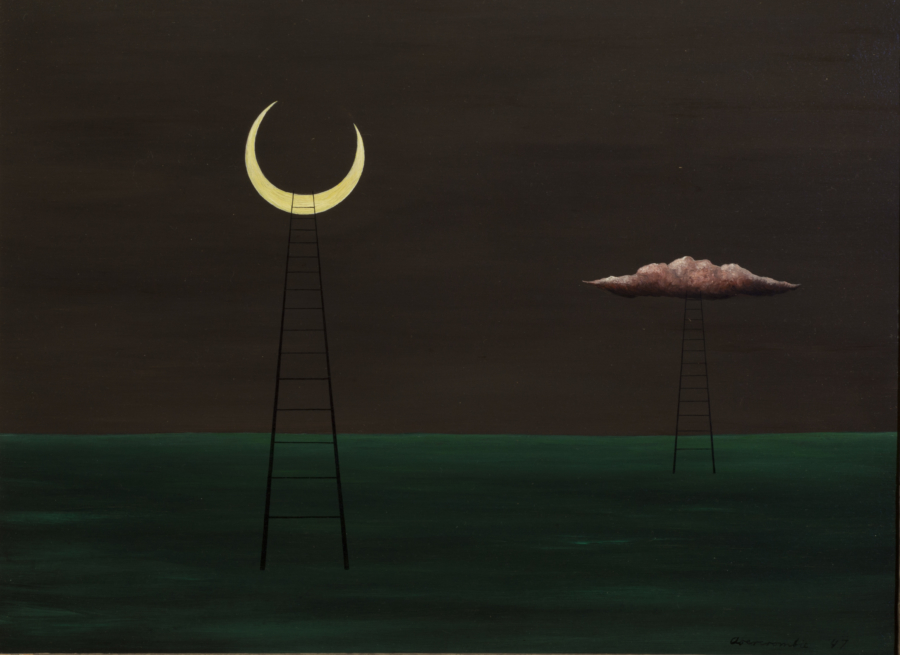January 23, 2018
Download as PDF
View on Chicago Tribune

Gertrude Abercrombie, “Two Ladders,” 1947, oil on masonite. (Illinois State Museum, Illinois Legacy Collection) (Illinois State Museum photo)
In Gallery 262 of the Art Institute there hangs a painting by a Chicago artist named Gertrude Abercrombie. It’s a compelling portrait, spooky actually, but it seems to attract little attention.
It sits next to a larger painting titled “Clown with Drum” by Walt Kuhn and both of these are near some much more famous paintings that draw much more attention, such as Edward Hopper’s “Nighthawks” and Grant Wood’s “American Gothic.” People take photos of these latter two with their phones and often stare at them for, oh, I don’t know, almost a minute.
There is so much to see at the Art Institute that you can’t blame people for hurrying through: “Where is that ‘Sunday in the Park’ thing anyway?”
Time’s tight even in the face of art. We look (glance, really) but rarely do we linger long enough to read the words that often accompany the painting. We don’t know much about the people who created the works: Oh yeah, Van Gogh, cut off his ear, right?
So, you could Google Gertrude Abercrombie, I suppose, or you could visit the Elmhurst Art Museum (elmhurstartmuseum.org) where many of her works — “I like to paint simple things that are a little strange,” she told a reporter when she was in her painting prime, which was the 1940s and 1950s — will be hanging on the walls through March 4. (They will later be mounted at the Illinois State Museum in Springfield from March 23 to June 15.
There has been no biography written of this woman. But she does have 65 biographical pages in Chicago writer Donna Seaman’s remarkable 2017 book, “Identity Unknown: Rediscovering Seven American Women Artists” (Bloomsbury). In her section about Abercrombie, Seaman writes that “journalists reveled in her enigmatic, even spooky art and her colorful life. Abercrombie’s cherished title, Queen of Bohemia, was well-earned.”
We get all the details of that life, most centered on the three-story Hyde Park home she shared with her two husbands and a daughter and hundreds of interesting others. That is where she hosted “now legendary jam sessions” with such pals/performers as Charlie Parker, Sarah Vaughan, Miles Davis and many others. There would be parties with such Chicagoans as Nobel Prize winning writer Saul Bellow and radio host-author Studs Terkel, who once wrote her a note that said, “To Queen Gertrude. You are regal — And we love you.”
She was very friendly with Thornton Wilder and met Gertrude Stein, who told Abercrombie, “(Your paintings) are very pretty but girl you gotta draw better.” She loved that then relatively new urban showcase offered by outdoor art fairs where, she said, “I met all kinds of people, classes, colors, creeds, everything.” She participated in these fairs sitting near her paintings, which leaned against her Rolls Royce.
If you are getting from these snippets from Seaman’s chronicle that Abercrombie was slightly kooky, you’re probably right. Or as Seaman puts it, “Abercrombie did not feel entirely comfortable in her own skin. She was not confident about love, marriage, or motherhood. She was insecure, often blue, lonely, angry, irascible, and narcissistic.”
There are not a great many people alive who knew Abercrombie, who was beset by health problems and became reclusive long before her death in 1977.
There was a teenager who could often be found in her house: Bruce Elliott, the author-painter who runs the Old Town Ale House, the walls of which are covered with his paintings.
Elliott’s uncle Hugh was a friend of Abercrombie’s and would often pay young Bruce to drive him from the suburbs to her home. He did this reluctantly at first but after meeting both Dizzy Gillespie and writer John Conroy on one trip he was hooked. He always offered to drive.
It was Gillespie who played at the wedding of Abercrombie and her second husband and who called her “the first bop artist. Bop in the sense that she has taken the essence of our music and transported it to another art form.”
Elliott writes about Abercrombie occasionally on his lively blog, “Geriatric Genius,” and that is where he wrote that he “learned to paint watching Gertrude.”
“It’s true,” he said earlier this week. “I would sit in the living room while her parties were going on around her and watch her paint. She would never answer any of the questions I was always asking her but she did let me observe. I learned a lot.”
Elliott admires Abercrombie’s work — he calls it “great” — and owns a few of her paintings. He plans to go to the Elmhurst show.
“What would she think of my painting?” he asked, playfully. “She would be able to spot in a second how she’s influenced my work and how much I’ve stolen from her style.”
As it always creatively does with its exhibitions, the Elmhurst Art Museum is embellishing the Abercrombie show with all manner of interesting programs. There will be a couple of jazz concerts and some talks by experts. On Feb. 17 the aforementioned Seaman will be there. Not sure what she might say, what insights she might provide. Art can by mysterious, one of its great joys, but she might offer this from her own book: “Abercrombie did not write about why she painted, or how she felt with a brush in her hand, or what she hoped people would glean from her work.”
What might you glean then from the title of her painting in the Art Institute, “Self-Portrait of My Sister,” when I tell you that Abercrombie was an only child?



